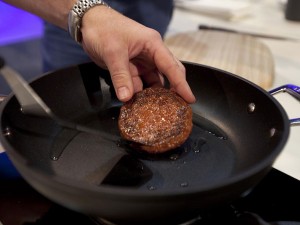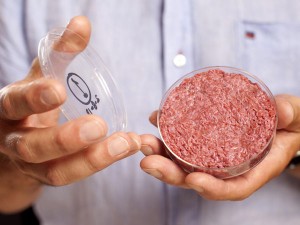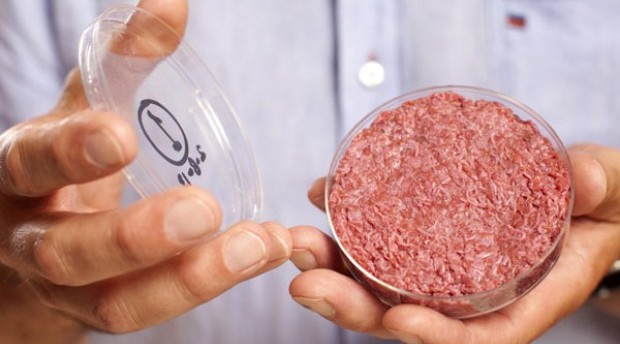LONDON—At a public tasting in London on Monday, Dutch scientists served a single hamburger made from cow stem cells. Some questions and answers about the science behind the revolutionary patty, how it could help combat climate change and what it actually tastes like.
Question: What are stem cells?
Answer: Stem cells are an organism’s master cells and can be turned into any other cell type in the body, i.e. blood, tissue, muscle, etc. Adult stem cells are found in small numbers in most human tissues, including bone marrow, fat and muscle.
Q: Why is the meat so expensive to produce?
A: The technology is new and scientists are making very small quantities of meat. There are no economies of scale to offset the initial high costs. If more scientists or companies start using the technology to produce more meat products, that could drop the price substantially and speed up its production.
Q: When could this meat be in stores?
A: Probably not for another 10 to 20 years. It would take years to refine the technology, encourage other producers and scientists to get involved, and overcome any regulatory issues.
Q: Who paid for the research?
A: Sergey Brin, cofounder of Google, underwrote the 250,000-euro ($330,000) project, which began in 2006. The Dutch government previously donated 2 million euros to the research.
Environment-friendly

Q: How is this better for the environment?
A: It could reduce the number of animals needed for the meat industry. Raising cows, pigs, chickens, etc., contributes substantially to climate change through the production of methane gas. Growing meat in the laboratory could reduce the impact on agricultural land, water and resources.
Q: How long does it take to grow a burger?
A: At the moment, a long time. It has taken two years for scientists to refine the process to grow enough meat. To actually grow enough meat for a couple of burgers would probably take about eight weeks. Actually forming the lab-made meat into a hamburger patty takes about two hours because scientists must put many separate strands together.
Q: What does the process involve?
A: Scientists first take a sample of muscles from a cow in a process they say is a painless biopsy. They then put those cells into a nutrient solution that helps them reproduce. After that, they are placed into a donut-shaped dish where the cells organize themselves into bits of muscle tissue. Electrical stimulation is sometimes used to exercise the muscle cells, which flex spontaneously. Once there are enough strands of meat (about 20,000 small strands), scientists can make a 140-gram (5-ounce) hamburger.
Implications
Q: What are the implications for vegetarians?
A: Peta, People for the Ethical Treatment of Animals, supports attempts to grow meat in labs because they say that will greatly diminish the amount of animal suffering. Donor animals are needed for the muscle cells, but taking those samples doesn’t hurt the animal. One sample can theoretically provide up to 20,000 tons of lab-made meat. But lab-grown meat is still meat.

Q: Is it possible to make other kinds of meat in the laboratory?
A: Yes. The science is theoretically the same, so the same techniques should also allow researchers to make chicken, fish, lamb, etc. Dutch researcher Mark Post, who led the research on the lab-made hamburger, initially started working with pig cells before switching to cows. He said it would even be possible to make meat products from other animals like penguins, though he has no plans to start on that.
Q: Can they make other meat products?
A: At the moment, scientists are only working on making processed or minced meat, because that is the easiest kind to replicate. Processed meat accounts for about half of the meat market. Post said it should be possible to make more complicated cuts like steaks or chops in the future, but that involves using more advanced tissue engineering techniques. He estimates that it might be possible to make a steak in about 20 years.
Q: Perhaps most importantly, what does it taste like?
A: Apparently it’s a little bland. At a public tasting on Monday in London, two food experts said the texture was convincing but that it lacked flavor; the lab-made burger does not contain any fat, but was cooked in oil and butter. Post said he wanted people to taste the burger without condiments, in its purest form.











































